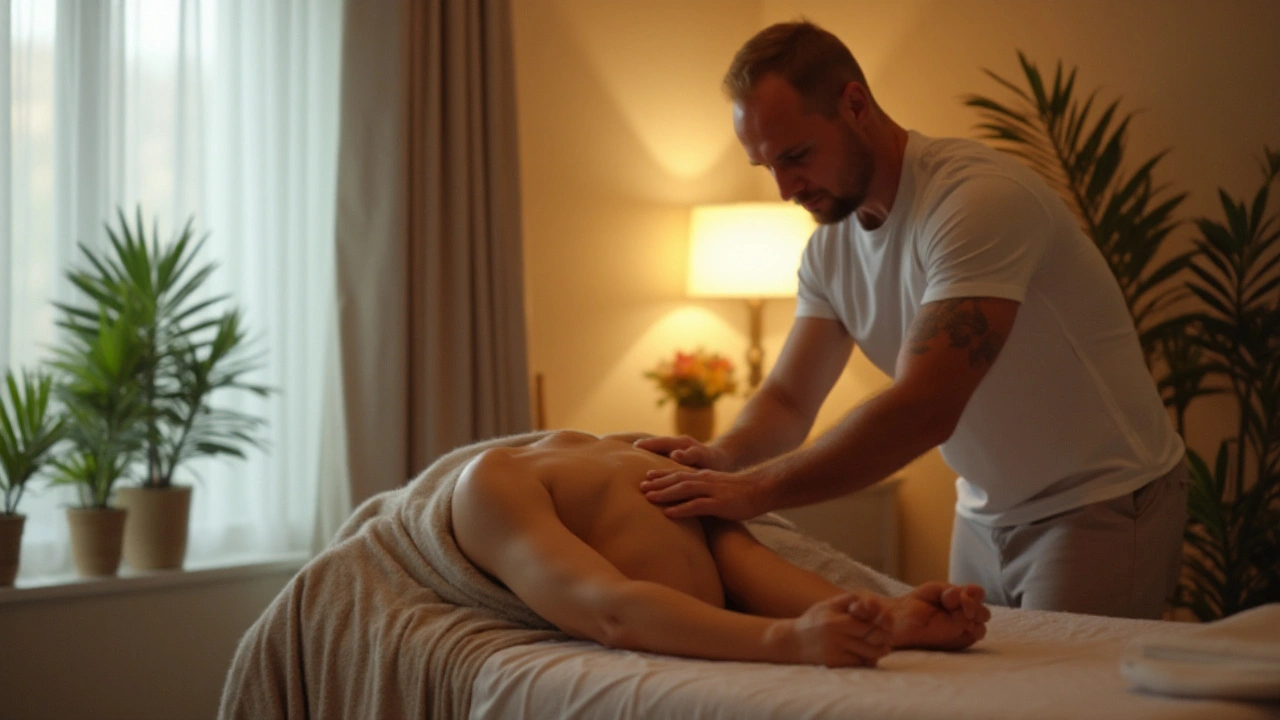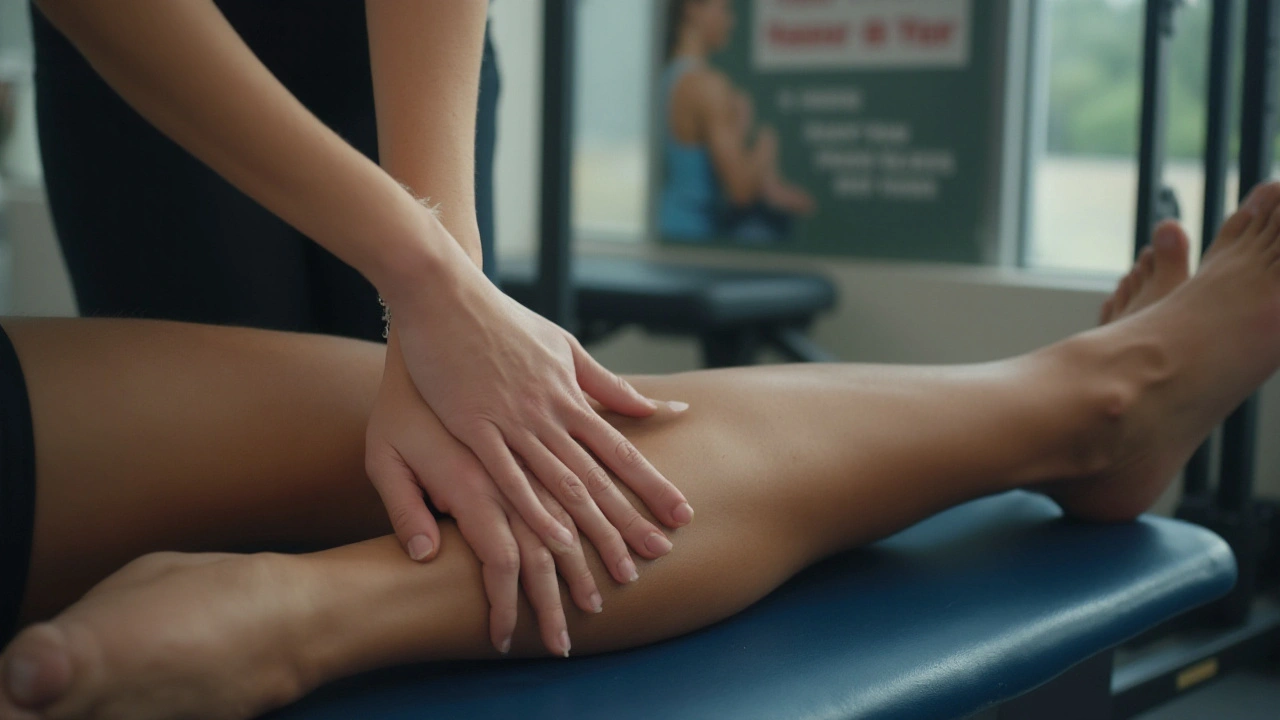Boost Athletic Performance with Swedish Massage Techniques

Swedish massage isn't just a luxury reserved for spa days; it’s a powerful tool for athletes aiming to boost their performance. Known for its long, gliding strokes, circular movements, and kneading techniques, Swedish massage targets muscles with precision and care. Athletes around the world have turned to this form of massage to enhance their training regimens and improve their game.
Good circulation is essential for athletic success, and Swedish massage excels at improving blood flow. By increasing circulation, it ensures that muscles receive adequate oxygen and nutrients, speeding up recovery and reducing soreness. Beyond just the physical benefits, this type of massage also provides significant mental relaxation, helping athletes maintain focus and reduce performance anxiety.
Consistency is key. Regular sessions can make a noticeable difference in flexibility, reducing the risk of injuries. It’s also an effective way to manage lactic acid build-up post-workout, which can make your muscles feel heavy and sore. Techniques such as effleurage and petrissage help in loosening tight muscles, further enhancing performance.
- Introduction to Swedish Massage
- Benefits for Athletes
- Techniques and Methods
- Tips for Incorporating Massage
Introduction to Swedish Massage
Swedish massage, a method developed in the early 19th century by Swedish physiologist Per Henrik Ling, has become one of the most popular and well-known types of massages worldwide. Its primary aim is relaxation, but it also boasts a multitude of health benefits, making it a favored choice among athletes. Unlike deep tissue massage, which focuses on reaching the deeper layers of muscle, Swedish massage involves long, flowing strokes, kneading, friction, and gentle tapping. These techniques work together to improve circulation, flexibility, and reduce muscle tension.
The distinct movements used in a Swedish massage can be broken down into five main techniques: effleurage (long gliding strokes), petrissage (kneading), friction (wringing or small circular movements), tapotement (rhythmic tapping), and vibration/shaking. Each has its unique benefits. For example, effleurage enhances blood flow and warms up the muscle tissue, preparing it for deeper work, while petrissage aids in breaking down adhesions in muscle fibers.
The regular practice of Swedish massage can bring about a host of benefits for athletes. Firstly, it promotes improved blood circulation. Better circulation means more oxygen and nutrients are delivered to the muscles, which is crucial for repair and recovery. A one-hour Swedish massage can increase the circulation levels in patients by 30 percent. The gentle yet firm strokes ensure that muscles are adequately relaxed and lactic acid build-up is minimized. This reduction in muscle soreness can hasten recovery times, allowing athletes to get back to training faster.
Moreover, flexibility is another key aspect where Swedish massage excels. By thoroughly working on muscle tissues and joints, it can help in extending the range of motion. This is especially beneficial for athletes whose sports require a high degree of flexibility. Consistent massage therapy sessions can result in less stiffness and a greater range of motion, thus better overall performance.
"There's substantial evidence that suggests massage therapy, including Swedish massage, can reduce muscle tension and increase relaxation, potentially leading to improved athletic performance." – American Massage Therapy Association
It's also important to highlight the mental benefits. Athletes are not immune to stress or performance anxiety. The calming nature of a Swedish massage can significantly reduce stress hormones while increasing the levels of feel-good chemicals in the brain like endorphins and serotonin. This mental unwind can be just as beneficial as the physical relaxation for peak performance.
Swedish massage, while beneficial on its own, can be easily integrated into an athlete's broader recovery and wellness routine. Whether you are a runner, a cyclist, or someone who dabbles in various sports, the advantages of this massage technique are countless. Regular sessions not only make muscles feel looser but also contribute to overall well-being, making it easier to maintain peak performance levels.

Benefits for Athletes
When it comes to maximizing athletic performance, Swedish massage offers a plethora of benefits that can make a significant difference. One of the primary advantages is the improvement in muscle recovery. Athletes constantly push their bodies to the limit, and the repetitive strain can lead to muscle fatigue and soreness. Swedish massage helps alleviate these issues by promoting blood flow and facilitating the removal of metabolic waste, such as lactic acid. This process not only speeds up recovery times but also reduces the risk of chronic injuries.
Another compelling benefit is the increase in flexibility. Flexibility is crucial for athletes, particularly those engaged in sports that demand a wide range of motion like gymnastics, swimming, or martial arts. By incorporating techniques like effleurage and petrissage, Swedish massage stretches muscle fibers and connective tissues, enhancing flexibility and reducing stiffness. This improved flexibility can lead to better performance and a lower chance of injuries.
Stress reduction is another significant benefit. Physical performance is not just about the body; the mind plays a critical role too. High-pressure environments and the constant drive to outperform can lead to mental stress and anxiety. Swedish massage provides a holistic approach to athlete care, offering mental relaxation alongside physical benefits. The gentle, rhythmic strokes activate the parasympathetic nervous system, which helps in reducing stress hormones and promoting a state of relaxation.
Enhanced circulation is another noteworthy advantage. Good blood flow is essential for delivering oxygen and nutrients to muscles, which is vital for performance and recovery. Increased circulation also helps in the efficient removal of waste products from the muscles. This dual action makes Swedish massage an invaluable tool for any athlete looking to maintain peak condition.
Interestingly, research supports these benefits. A study published in the Journal of Sports Medicine showed that athletes who received regular Swedish massages experienced a 30% reduction in muscle soreness and a 15% improvement in muscular flexibility.
The benefits of Swedish massage extend beyond just physical recovery. "Regular massage therapy can significantly improve an athlete's performance by enhancing flexibility, reducing muscle soreness, and promoting mental relaxation," says Dr. Jane Thompson, a renowned sports medicine specialist.
Another vital aspect to consider is the role of Swedish massage in pain management. Athletes often deal with pain from injuries or intense training sessions. Swedish massage offers a natural and effective way to manage pain without resorting to medications. Techniques like kneading and friction target deep muscle layers, helping to alleviate pain and discomfort.
Lastly, Swedish massage promotes better sleep patterns, an often-overlooked factor in athletic performance. Quality sleep is crucial for muscle recovery, mental alertness, and overall well-being. The relaxation induced by Swedish massage can help athletes achieve deeper, more restful sleep, thereby enhancing their performance on the field or court.

Techniques and Methods
Swedish massage is celebrated for its simplicity and effectiveness. It involves five distinct techniques, each tailored to address different needs of the muscle and tissue structure. These techniques – effleurage, petrissage, friction, tapotement, and vibration – form the pillars of Swedish massage therapy.
Effleurage is often the starting point. It consists of long, smooth strokes that warm the muscles and prepare them for deeper work. This technique aids in increasing blood circulation and reducing stress levels, making it a favorite among athletes. Using light to medium pressure, effleurage strokes follow the length of the muscle fibers, helping to transport the body's natural lubricants, easing tension, and promoting relaxation.
Petrissage follows effleurage and involves kneading, rolling, and squeezing muscles in a rhythmic manner. This technique targets deeper layers of muscle tissue, breaking down knots and smoothing out tight areas. Particularly beneficial for athletes, petrissage enhances flexibility, makes tight muscles more pliable, and prepares the body for intense physical activities. By focusing on muscle groups prone to tightness, such as the hamstrings, quadriceps, and calves, petrissage also helps in the recovery process by eliminating muscle fatigue.
The friction technique takes center stage when a more targeted approach is needed. Small, circular movements using the thumb or fingertips exert deeper pressure on specific areas. This technique is effective for breaking down adhesions and scar tissue that can limit an athlete’s range of motion. Friction works wonders in areas that endure heavy loads during exercise, such as shoulders and lower back. By addressing these problem zones, athletes often experience an immediate improvement in mobility and a reduction in pain.
Tapotement, commonly known as “percussion,” involves brisk tapping or drumming motions using the side of the hand or fingertips. This invigorates the muscles, boosts circulation, and stimulates nerve endings. For athletes seeking a quick wake-up call for their muscles, tapotement offers a fast and effective solution. It’s often used toward the end of a massage session to rejuvenate muscles and prepare them for action. Although it’s executed with a lighter touch, tapotement has a significant impact by awakening muscle groups and enhancing neural activity.
Lastly, vibration encompasses a broad spectrum of rapid shaking or rocking movements that aim to loosen muscle fibers and promote relaxation. This technique is particularly useful post-training sessions when an athlete’s muscles need soothing. Vibration can either be applied manually or with tools designed to deliver rapid vibrations across muscle groups. The approach fosters a state of relaxation, reducing muscle pain and improving recovery rates.
“Swedish massage can greatly benefit athletic performance by improving muscle flexibility and reducing recovery time,” says Dr. Michael Smith, an expert in sports medicine.
Understanding these core techniques opens the door to more effective application and integration into an athlete’s routine. Each method addresses unique physical demands and contributes to a holistic approach to muscle care. As these techniques become a staple in training regimens, athletes can expect noticeable improvements in their performance, recovery, and overall physical well-being.

Tips for Incorporating Massage
Incorporating Swedish massage into your athletic routine can lead to a myriad of benefits, but it’s important to integrate it correctly for the best results. First, it's essential to schedule regular massage sessions to maintain the positive effects on your body. Ideally, this means booking a session once a week or bi-weekly, depending on the intensity of your training. This regularity ensures that your muscles stay relaxed and flexible, preventing injuries and improving your performance over time.
Equally crucial is the timing of your massage. Many athletes find it beneficial to have a massage after their most strenuous workout of the week. This helps to reduce muscle soreness and promote faster recovery. On the other side of the spectrum, some athletes prefer a light massage a day before a big game or event to keep their muscles loose and ready for peak performance. It's all about finding what works best for your body.
Choosing the right massage therapist is another key factor. Look for someone who is experienced with *athletes* and understands the specific benefits of *Swedish massage*. An expert will know exactly how to tailor the massage to suit your particular needs. A good therapist will also be able to advise on the perfect intensity and techniques to use, whether that's more focused kneading on tight muscles or gentle gliding strokes to enhance relaxation.
According to sports physiologist, David Sandler, “Regular massage can significantly enhance an athlete’s capability and endurance by ensuring muscles function optimally.”
Don’t forget to communicate openly with your massage therapist. Let them know about any areas of discomfort, ongoing injuries, or specific goals you have. This open dialogue helps in customizing each session to address your unique needs and ensures that you're getting the most out of every session. Whether you are preparing for a big event or simply aiming to maintain your fitness, effective communication makes a world of difference.
Creating an at-home massage routine can also play a role in maximizing the benefits of *Swedish massage*. Invest in some quality massage tools, like foam rollers or massage balls, to help you target specific areas between professional sessions. Using these tools for a few minutes each day can help maintain flexibility and work out any tightness that develops from daily training.
Staying hydrated before and after your massage is another important tip. Drinking plenty of water helps to flush out the toxins released during the massage, aiding in muscle recovery. It also helps keep your muscles pliable and less prone to cramps or injuries. Think of it as giving your body the fuel it needs to heal and perform better.
Lastly, be mindful of your overall body care routine. Incorporate proper stretching before and after workouts, and ensure you're following a nutritious diet that supports muscle health. Combining these practices with regular *Swedish massage* creates a holistic approach to improving your athletic performance, allowing you to train harder and recover smarter.





